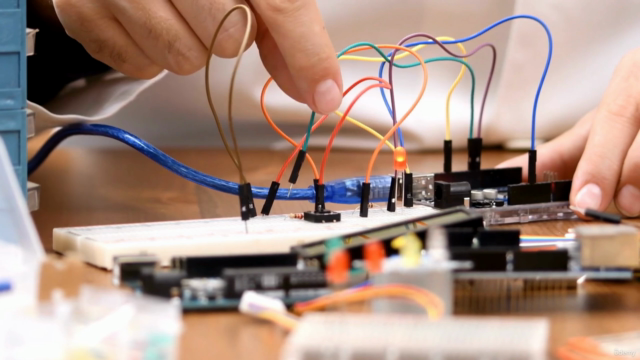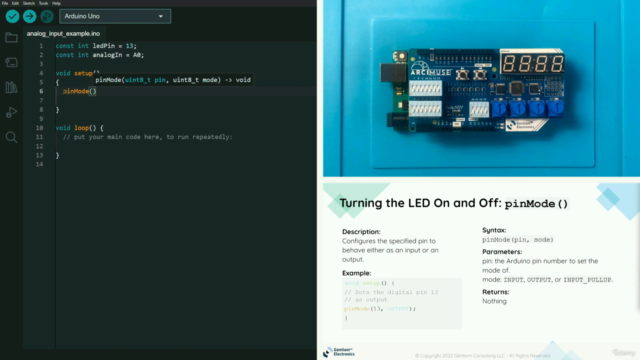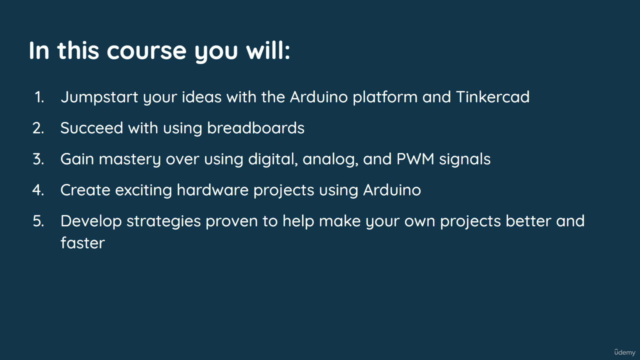Step-by-Step Arduino for Beginners: Mini-Course

Why take this course?
🌟 Step-by-Step Arduino for Beginners: 2023 Mini-Course 🌟
Course Headline:
Master the foundation of Arduino programming and electronics required to prevail in robotics, IoT, and more!
Objectives:
The primary goal of this mini-course is to familiarize you with the world of Arduino, a versatile platform that's a favorite among beginners and seasoned engineers alike. By completing this course, you will:
- Gain a solid understanding of the essential electronics concepts behind Arduino programming.
- Acquire hands-on experience with setting up and utilizing the Arduino platform.
- Develop the ability to interpret and work with digital and analog signals.
- Learn how to implement PWM (Pulse Width Modulation) signals for various applications.
- Engage with numerous practical examples that demonstrate real-world applications of Arduino.
- Equip yourself with the tools necessary to embark on your own projects after the course.
What You Will Learn:
This course is meticulously designed to guide you through a variety of topics, including:
🔹 Setting Up and Using the Arduino Platform:
- Understanding the hardware components of an Arduino board.
- Learning how to install the Arduino IDE (Integrated Development Environment) and write your first sketch.
🔹 Using a Breadboard:
- Mastering the basics of prototyping with a breadboard for building circuits without soldering.
- Knowing how to connect components like LEDs, resistors, and capacitors.
🔹 Digital Signals:
- Understanding digital output and input operations on Arduino pins.
- Learning how to control LEDs using digital pins.
🔹 Analog Signals:
- Getting to grips with analog input and output functions for reading sensors or controlling devices with varying intensity levels.
🔹 PWM Signals:
- Discovering the use of PWM to create different brightness levels of LEDs or control the speed of motors.
🔹 Practical Examples Using Arduino:
- Following step-by-step examples that apply what you've learned in practical scenarios.
🔹 Tools for Self-Directed Learning and Projects:
- Preparing you with the knowledge to tackle more complex projects on your own.
Teaching Methodology:
To ensure a comprehensive learning experience, this course adopts a three-pronged approach:
-
LEARN:
- Each topic is introduced and its theory is thoroughly explained in an engaging lecture format.
-
PRACTICE:
- You will work through examples together with the instructor to solidify your understanding and skills.
-
MASTER:
- You will then be challenged to apply what you've learned by working on independent projects, culminating in a final project that encapsulates all the knowledge and skills acquired throughout the course.
Course Structure:
This mini-course contains a wealth of content designed to take your learning from the basics to a level where you can confidently tackle more complex Arduino projects. Here's what you can expect:
- Video Content: Approximately 2 hours of instructional videos that cover all the topics.
- Example Projects: Four carefully selected example projects that will help you apply your newfound knowledge in a hands-on manner.
- Challenge Projects: Three challenge projects designed to push your skills further and encourage problem-solving.
- Final Project: A comprehensive project that brings together everything you've learned, providing a satisfying capstone to the course.
Important Notes:
To follow along with this course effectively, you have two options:
-
Arduino Simulator (Tinkercad): A free software solution that allows you to simulate your Arduino projects in a virtual environment. An account with Tinkercad is required.
-
Recommended Hardware Kit: For those who prefer or require real-world hardware, a recommended kit can be purchased to accompany the course material. Please watch Lecture 5 for guidance on choosing the best option for your learning style and goals.
Embark on your journey into the world of Arduino today, and unlock endless possibilities in electronics and programming! 🌈
Course Gallery




Loading charts...